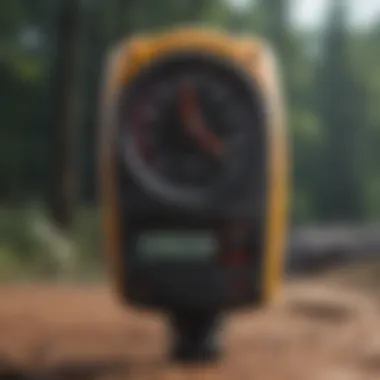Understanding Wind Measurement Instruments for Sports


Intro
Wind measurement is a crucial topic for various fields, including meteorology, extreme sports, and environmental studies. Understanding how to accurately measure wind can greatly enhance experiences, whether one is surfing, rock climbing, or mountain biking. The tools available for this purpose vary in complexity and functionality, and so do their applications.
This section will guide readers through the techniques for measuring wind, the gear required, and essential safety measures. The insights here are not only for professionals but also for enthusiasts wanting to elevate their skills and knowledge.
By delving into this topic, one gains a deeper appreciation of the dynamics of wind and its influence on outdoor adventures.
Prelude to Wind Measurement
Wind measurement plays a crucial role in various domains, including meteorology, environmental science, and outdoor sports. Understanding the forces and behaviors of wind can lead to more informed decision-making and ultimately enhance safety and performance in multiple activities. In this article, we will explore the instruments used for wind measurement and highlight their significance.
The Importance of Wind Measurement
Wind affects numerous aspects of our daily lives. It influences weather patterns, impacts aviation, and plays a vital role in renewable energy generation. Accurate wind measurement is essential for forecasting weather, which helps communities prepare for storms or floods.
- For athletes, having precise wind data ensures optimal performance. Unpredictable wind can affect activities like sailing, paragliding, or mountain biking.
- In environmental studies, wind measurements help in pollution dispersion modeling, allowing researchers to understand how contaminants travel and impact ecosystems.
In essence, wind measurement instruments provide a framework for interpreting natural phenomena and developing strategies in various fields, enhancing both safety and utility.
Applications in Extreme Sports
Extreme sports depend heavily on favorable wind conditions. Athletes must assess wind speed and direction to ensure a safe and successful experience. The impact of wind on sports varies greatly depending on the activity.
- Surfing: Wind conditions affect wave formation. Surfers often chase offshore winds which create perfect wave conditions.
- Paragliding: Pilots must know wind speed and direction for safe takeoffs and landings.
- Kiteboarding: Wind power is essential here. Knowing wind patterns helps the rider make informed decisions about when to go out.
- Mountain Biking: Wind can create challenges on trails, especially in steep or exposed areas. Riders must adapt their techniques to varying conditions.
Understanding the intricate relationship between wind dynamics and extreme sports can give athletes a competitive edge. Choosing the right wind measurement instruments can significantly enhance their performance and safety.
Key Principles of Wind Measurement
Understanding the key principles of wind measurement is essential for grasping how these instruments operate and their importance in various applications. Wind measurement isn't merely a scientific curiosity; it is a critical factor in multiple fields such as meteorology, marine navigation, agriculture, and, notably, extreme sports. Adequate wind data can significantly influence decision-making processes, safety, and performance in outdoor activities. Therefore, recognizing how wind speed and direction are measured offers invaluable insights into planning and executing any wind-dependent endeavor.
Understanding Wind Speed and Direction
Wind speed and direction are the two fundamental parameters in wind measurement. Wind speed refers to how fast the wind is moving through a given space. It is typically measured in meters per second or miles per hour. Accurate wind speed measurement is crucial. It informs athletes whether conditions are safe for their activities, helps in weather forecasting, and affects various ecological systems.
Wind direction indicates where the wind is coming from. This is generally expressed in degrees, with 0° representing true north. For example, a wind blowing from the east is measured at 90°. Knowing the wind direction is vital for sports such as sailing and surfing, as it affects both performance and safety. Tools like wind vanes and anemometers help determine these essential measurements. The separation between speed and direction provides a comprehensive view of the wind, assisting in better strategic planning during outdoor activities.
Factors Affecting Wind Measurements
Wind measurements can be influenced by various environmental factors. Understanding these influences can enhance the reliability of wind data. Here are some of the most significant factors affecting wind measurements:
- Topography: Landscape features such as hills, valleys, and buildings can disrupt wind flow, causing variations in measurements.
- Temperature Differences: Changes in air temperature can affect air density and, consequently, wind speed. Hot air rises while cool air sinks, impacting local wind behavior.
- Obstructions: Trees and structures can block or redirect wind, leading to inaccurate data. Accurate placement of instruments is essential for obtaining reliable results.
- Instrument Calibration: Regular calibration of measurement instruments ensures they provide accurate data over time. Without calibration, readings can deviate from actual wind conditions.
Understanding these factors is critical for anyone relying on wind data for assessment or planning. Accurate interpretation leads to better outcomes, particularly in high-stakes environments such as extreme sports.
"Reliable data on wind speed and direction can make the difference between a successful extreme sports experience and a perilous one."
By appreciating the core concepts of wind speed and direction, as well as the factors that can influence measurements, enthusiasts can make informed decisions, enhancing both enjoyment and safety in wind-based activities.
Types of Wind Measurement Instruments
Wind measurement instruments are fundamental in understanding and predicting various atmospheric conditions. They serve crucial roles in meteorology, outdoor sports, and environmental studies. Selecting the right instrument depends on several factors, including accuracy, ease of use, and suitability for specific activities. This section will explore different types of wind measurement instruments, focusing on their unique features and practical advantages.
Anemometers
Anemometers are essential tools used to measure wind speed. They are widely adopted due to their reliability and precision. Anemometers come in various types, each designed for specific conditions and uses, making them a popular choice for extreme sports enthusiasts who depend on accurate wind readings.
Types of Anemometers
There are several types of anemometers available, including cup, vane, and digital models. Each type has its own method of measuring wind speed.
- Cup Anemometers: Made of three or four cups that spin on a vertical axis, these devices are known for their simplicity and effectiveness. Their main advantage is their accuracy in high wind conditions.
- Vane Anemometers: These consist of a rotating vane that aligns with the wind direction. They are compact and portable, making them suitable for outdoor sports.
- Digital Anemometers: Equipped with electronic sensors, they offer real-time data and can display wind speed in various units. Their versatility is a key characteristic, especially for serious athletes.
The unique advantage of anemometers is their ability to provide immediate feedback on wind conditions, which is critical in situations like surfing or sailing.


Accuracy and Calibration
The accuracy of anemometers is paramount. Wind measurement can significantly influence decision-making in extreme sports. Thus, regular calibration is important to maintain precision.
- Calibration Needs: Most anemometers require calibration against known wind speeds to ensure they perform accurately.
- Impact of Accuracy: High accuracy translates to better planning and safer conditions for activities such as kite surfing or paragliding.
Anemometers featuring digital displays often include built-in calibration options, a key selling point for those looking for easy maintenance in instruments.
Usage in Outdoor Sports
Anemometers are widely used in outdoor sports. The ability to measure wind speed helps athletes gauge conditions before embarking on their activities.
- Sporting Relevance: Usage in various sports, including windsurfing, sailing, and mountain biking, shows their versatility.
- Real-Time Data: Access to instant wind data enables athletes to analyze conditions dynamically, leading to smarter choices during competitions.
The integral feature of portability makes hand-held anemometers a favorite choice among adventurers.
Wind Vanes
Wind vanes play a critical role in determining wind direction. They are simple, yet effective tools that complement anemometers for comprehensive wind assessment.
Design and Functionality
Wind vanes typically consist of a rotating arrow that points into the wind. The design is straightforward but effective.
- Simplicity: Their basic mechanism allows for easy reading of wind direction, essential in sports applications.
- Functionality in Use: Placed atop poles or masts, these instruments provide a clear indication of wind orientation, which is critical for sports like sailing and paragliding.
The unique feature of wind vanes is that they help track changes in wind direction, contributing to informed decision-making in rapidly changing conditions.
Incorporation in Adventure Activities
The incorporation of wind vanes in outdoor sports is increasingly recognized. Their ability to provide directional feedback is invaluable.
- Addressing Challenges: In sports like kiteboarding, knowing wind direction is essential for safe maneuvering.
- Ease of Mounting: Many wind vanes are easily mounted on various surfaces, adding to their flexibility for outdoor use.
Interest in using wind vanes in combination with other measuring devices enhances their effectiveness in monitoring conditions for activities.
Sonic Anemometers
Sonic anemometers utilize sound waves to measure wind speed and direction. They are increasingly popular among professionals due to their advanced technology.
Operational Mechanism
These instruments measure the time it takes for sound waves to travel between sensors. The changes in wind speed affect this travel time, allowing for precise measurements.
- Real-Time Measurements: Sonic anemometers provide real-time and highly accurate data, which is crucial for research activities and extreme sports applications.
- Non-Intrusive Nature: Unlike mechanical devices, sonic anemometers have no moving parts, reducing wear and tear, and making them durable.
This unique feature of durability combined with high accuracy is what makes sonic anemometers an advanced tool for professionals.
Advantages for Extreme Sports Enthusiasts
For extreme sports enthusiasts, sonic anemometers offer distinct advantages. They deliver reliable data essential for safe participation in high-risk activities.
- Precision in Conditions: Accurate information helps in preparation for sudden changes in wind, which is extremely valuable in sports like skiing and paragliding.
- Durability in Use: Their resistance to adverse conditions makes them a favorite for outdoor adventurers.
These features help athletes make informed decisions, thereby enhancing safety and performance.
Pitot Tubes
Pitot tubes measure fluid flow velocity and are often used in conjunction with other measuring devices for comprehensive assessments of wind conditions.
Working Principle
Pitot tubes function based on the principle of pressure differences. They gauge the difference between static and dynamic pressure to determine wind speed.
- Mechanism Explained: By measuring the pressure of the fluid, these tubes calculate how quickly the wind moves around them.
- Reliability in Data: Pitot tubes provide consistent readings, crucial for scientific research and development purposes.
The unique benefit of pitot tubes is their ability to function in environments where other instruments might fail.


Applications in Research and Development
In the realm of research and development, pitot tubes are vital. They are commonly used in aerodynamic studies and environmental monitoring.
- Scientific Relevance: Many scientific projects rely on accurate wind data provided by these tools.
- Advanced Projects: Research in wind energy, aviation, and meteorology often utilizes pitot tubes for their accuracy and reliability.
Their unique feature in providing precise measurements in various conditions highlights their importance in advancing knowledge in wind dynamics.
Selecting the Appropriate Wind Instrument
Choosing the right wind measuring instrument is crucial, especially for those involved in outdoor activities like surfing, climbing, or biking. The effectiveness of these instruments can drastically affect not only performance but safety as well. An instrument that is too inaccurate can lead to improper planning and potentially dangerous situations.
There are various factors influencing the choice of an instrument, with each one catering to specific needs and circumstances. By understanding these factors, users can make informed decisions when selecting their instruments. This section discusses key considerations, which will be beneficial for thrill-seekers and extreme sports enthusiasts.
Factors to Consider
Accuracy Requirements
Accuracy in wind measurement is paramount. Instruments must provide reliable data to ensure users can make educated decisions. The accuracy requirements often depend on the activity being pursued. For example, a surfer needs precise wind speed readings to read wave conditions effectively.
A significant characteristic of accuracy is calibration. Instruments must be calibrated properly to achieve reliable results. Many high-quality options on the market come with manufacturer specifications for calibration procedures, which enhances their credibility.
However, instruments that prioritize accuracy can also come with higher price tags, which may not be suitable for everyone.
Durability in Extreme Conditions
Durability is another crucial aspect. Outdoor adventures often happen in challenging environments where instruments may be exposed to harsh weather, dust, or moisture. A durable instrument can withstand these conditions, ensuring longevity and consistent performance.
A key characteristic of durable instruments is their quality materials, like reinforced plastics or stainless steel casings, which resist corrosion and damage. Many extreme sports enthusiasts prefer these models to avoid repeated replacements or repairs.
While durability adds resilience, it can also increase weight. Heavy instruments may not be ideal for all users, especially those seeking light and portable options.
Portability and Ease of Use
Portability plays a significant role in instrument selection. Compact designs allow users to carry their devices easily without adding excessive weight. This becomes especially important for activities like rock climbing where minimalism is vital.
Ease of use is also critical. Instruments should have clear displays and straightforward interfaces to enhance user experience, even under pressure. Many modern options come with mobile applications for easier data tracking and adjustments.
Sometimes, portable designs may sacrifice some degree of accuracy or durability, which could hinder their overall effectiveness in the field. Users must therefore balance these factors against their specific needs.
Comparative Analysis of Instruments
When comparing different wind measurement tools, users must look at features in relation to their chosen sport.
- Anemometers are favored for their speed accuracy but may be bulkier.
- Wind vanes provide direction details but can be less portable.
- Sonic anemometers offer rapid readings and are highly durable, yet they come at a higher cost.
- Pitot tubes are precise and often used in research settings but may not be user-friendly for everyday activities.
An in-depth understanding of each instrument's advantages and disadvantages ensures better selection aligned with individual requirements.
Interpreting Wind Data
Interpreting wind data is crucial for anyone involved in outdoor activities, especially for those engaged in extreme sports. Wind data provides insights that influence safety, performance, and overall experience. Accurate interpretation can distinguish between success and risk in activities like surfing, climbing, and biking. Knowledge of wind conditions helps in making informed decisions, ultimately enhancing enjoyment and safety.
Understanding Wind Data Reports
Understanding wind data reports is fundamental to grasping the complexities of wind behavior. These reports typically include information on wind speed, direction, and gusts. For example, a report might indicate that the wind is blowing at 15 mph from the northwest with gusts reaching up to 25 mph. This information can greatly affect the kind of decisions made during outdoor activities.
Key elements to look for in wind reports include:
- Wind Speed: Expressed in miles per hour (mph) or kilometers per hour (kph). This is essential for evaluating conditions.
- Wind Direction: This tells you where the wind originates. It is often indicated in degrees or in relation to compass directions.
- Wind Gusts: Sudden increases in wind speed. Gusts can affect stability, making them particularly important for activities such as rock climbing.
By carefully analyzing these components of wind data, individuals can anticipate how the wind will influence their activities. For instance, a surfer may prefer a steady offshore breeze, while a climber must be alert to strong gusts that could destabilize them.
Using Wind Data for Planning Activities
Using wind data for planning activities is essential, especially for thrill-seekers aiming to maximize their outdoor experiences. Having a clear understanding of wind conditions allows individuals to align their plans with optimal weather factors, ensuring safety and enjoyment.


Here are some important considerations for utilizing wind data in planning:
- Timing: Knowing when to engage with specific activities based on prevailing winds can enhance performance. For instance, kite surfers often plan their sessions during windy periods to achieve better flight.
- Location Selection: Certain areas may have different wind patterns. High cliffs might be windier than a sheltered valley. Choosing the right spot can lead to better outcomes.
- Safety Measures: Planning ahead using wind forecasts can prevent dangerous situations. Knowledge of potential gusts or sudden changes can help in making safe choices, especially in climbing or biking where wind can significantly impact physical stability.
Impact of Wind Conditions on Extreme Sports
Understanding the impact of wind conditions is crucial for anyone engaged in extreme sports. Wind does not merely influence the physical actions of participants; it also shapes the safety and overall experience of outdoor activities. For surfers, rock climbers, and bikers, knowledge of wind dynamics can mean the difference between a thrilling adventure and a dangerous situation.
Wind can alter the characteristics of a location significantly. For example, it may change the swell patterns for surfers, create hazardous conditions for climbers, or affect the handling of a bike on twisting trails. Therefore, accurate wind measurement becomes indispensable for these practitioners.
Various factors must be considered when evaluating wind conditions. These include not only wind speed and direction but also the terrain and weather systems in the area. As such, both novice and experienced athletes should pay close attention to wind data before heading out.
"Wind is not just a factor; it is an element that shapes the entire outdoor experience."
Wind Effects on Surfing
For surfers, wind influences wave formation and quality. Side winds may cause choppy water, adversely affecting ride quality. Offshore winds, conversely, can create clean, well-formed waves. It is essential for surfers to stay updated on local wind patterns. An anemometer can help track these changes accurately to optimize surfing conditions.
Here are some key effects of wind on surfing:
- Wind Direction: Offshore winds help maintain wave shape, while onshore winds can deteriorate it.
- Wind Speed: Strong winds can make it difficult for surfers to paddle out and catch waves, leading to fatigue.
- Timing: Experienced surfers often know the right time to go based on wind forecasts, which can prevent wasted trips.
Wind Considerations for Rock Climbing
Rock climbers must also assess wind conditions carefully. High winds can create dangerous situations, especially on exposed ridges or cliffs. Wind chill can lower temperatures significantly, increasing the risk of hypothermia.
Important considerations include:
- Stability: Winds can dislodge loose rocks, posing serious threats to climbers.
- Planning: It is essential to check wind conditions on the day of the climb to choose appropriate routes.
- Gear: Proper equipment can help mitigate the effects of wind, including insulation and protection from falling debris.
Biking in Varied Wind Conditions
Cyclists experience wind effects just as much as surfers and climbers. Wind can change how a bike handles, especially in downhill or high-speed situations. Understanding wind conditions helps cyclists maintain control and reduce fatigue.
Key points for cyclists include:
- Headwind vs Tailwind: While headwinds can slow progress, tailwinds can enhance speed.
- Crosswind Awareness: Crosswinds can push a cyclist off course, making stability a concern, particularly on narrow paths or during races.
- Aerodynamics: Wind direction can affect the choice of riding position, with a more aerodynamic posture often necessary in strong wind conditions.
In summary, wind conditions are a fundamental aspect of extreme sports that demand attention and understanding. For participants, this knowledge translates into enhanced safety and performance. With the right instruments for measuring wind, athletes can make smarter decisions that amplify their enjoyment and reduce risks.
Technological Advances in Wind Measurement
Technological advances in wind measurement play a crucial role in enhancing the accuracy and efficiency of how we collect and interpret wind data. Innovations in this field continually shape our understanding of wind dynamics, especially in applications related to extreme sports and outdoor pursuits.
One significant aspect is the integration of digital technology, which has transformed traditional instruments into sophisticated devices capable of providing real-time data. These advancements not only improve the measurement process but also enhance the user experience, making it more intuitive and streamlined. The precise data gathered through these modern instruments enable athletes and enthusiasts to make informed decisions, ensuring that their activities are conducted safely and effectively. Moreover, accurate wind measurements are essential for weather predictions and environmental monitoring.
Integration of Digital Technology
The integration of digital technology into wind measurement tools has revolutionized the way data is gathered and analyzed. Digital anemometers, for instance, provide instant wind speed readings with high precision. Many devices now come equipped with Bluetooth or Wi-Fi capabilities, allowing users to connect to smartphones or tablets for easier access to information. These features allow data to be stored, shared, and analyzed quickly, fostering a more collaborative approach among wind sports enthusiasts.
In addition, the use of sensors has advanced significantly. Modern devices often use ultrasonic sensors, which measure wind speed and direction without mechanical moving parts. This technology reduces wear and tear, thereby increasing longevity and reliability in harsh conditions. Furthermore, the digital display of readings allows users to easily interpret large amounts of data at a glance.
Use of Mobile Applications
Mobile applications complement the advancements in wind measurement instruments by providing real-time data and user-friendly interfaces. Many applications now connect seamlessly with wind measurement devices, offering real-time updates on wind conditions relevant to specific sports or activities. This can include data on gust speeds, wind direction, and even forecasts relevant for outdoor adventures.
Apps like Windy or the iKitesurf app are examples of tools that aggregate data from various sources, including personal weather stations and national meteorological services. Users can customize notifications based on their interests, such as optimal wind conditions for kite surfing or sailing. The accessibility of this information means that thrill-seekers can always stay informed, significantly improving safety and enhancing their experience.
By harnessing the power of mobile technology, users are empowered to make real-time decisions, maximizing their outdoor experiences.
As these technological advances continue to evolve, the future of wind measurement looks promising, offering even greater precision and integration, which will surely benefit extreme sports enthusiasts and outdoor adventurers alike.
Culmination
Summary of Key Points
- Variety of Instruments: Different types of wind measurement devices, each serving specific purposes while measuring speed, direction, and variability of wind.
- Importance in Sports: For extreme sports like surfing, rock climbing, and biking, accurate wind data can determine success and safety.
- Technological Integration: Modern advancements in technology have revolutionized how wind data is collected and used, with mobile applications and digital instruments enhancing convenience and accuracy.
Future Directions in Wind Measurement
The future of wind measurement is leaning towards even more sophisticated technologies. This includes:
- Smart Sensors: Development of smart sensors that can provide real-time data in varied conditions. These sensors can interact with other devices to deliver comprehensive environmental readings.
- Data Analytics: More emphasis on big data analytics. As data collection becomes more advanced, analyzing vast amounts of wind data can lead to better predictions and applications in sports and environmental studies.
- User-friendly Developments: Increased demand for portable and easy-to-use instruments, making wind measurement accessible to more thrill-seekers and adventure enthusiasts.







